The Beginning
In 1792 Captain George Vancouver aboard his ship, the HMS Discovery, came upon a large inlet of the Pacific Ocean and sailed into this inland sea anchoring off what is now known as Restoration Point on Bainbridge Island. He then began promptly naming every landmark in sight after members of his crew, royal family and fellow Captains and Admirals. He sent his second in command, Lt. Peter Puget down the various waterways to explore this new land. Captain Vancouver named this body of water, south of Elliot Bay, Puget Sound in honor of his trusted Lieutenant and everything north of Elliot Bay was called Admiralty Inlet. During their exploration, they came upon a large channel of water. Believing this was simply a canal that connected to the rest of the sound, they did not explore further than where current day Hoodsport is located. Capt. Vancouver named this body of water after the man who sent him on this journey of exploration, Lord of the Admiralty, Samuel Hood, hence the name Hood Canal.
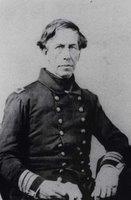
In 1841, US Naval Lieutenant Charles Wilkes led the US Exploring Expedition (the Ex Ex) and extensively mapped the waterways of the northwest from Oregon to Washington. He sent Lt. Augustus L. Case (Case Inlet) and a crew from the USS Vincennes to chart the Hood Canal. That team identified the cove where the camp would later be located, placed it on the map and gave it the Indian name of Hoo Etzen Harbor. They also kept the native names for Pulali Point (meaning “sand” or “dust”) and Wawa Point. The Native Americans would come to this cove seasonally to pick berries and to fish. Indeed, what was to become Camp Parsons served as a summer camp in many ways to those Native Americans. They would also bury their dead on the arms of the bay that form the cove (these graves, by historical account, were removed when settlers came to the peninsula). A portion of the waterfront, particularly swim beach, played prominently in local tribal myth. The area in and around camp was surveyed in 1871 by Edgar Morgan for the Bureau of Land Management who noted that the best area for agriculture was in the Dosewallips river valley where the current town of Brinnon is located. He also noted that the land which camp is situated on had already been logged by that time. Here is his account:
“The quality of the land in this Township is considerably below the average, there being but one hundred and fifty acres situated in the valley of the Dosewallips which is 1st rate. The balance of the Township is mountainous and the surface of the ground has the appearance of having been burnt over many times, part of the timber having been destroyed and the rocks also showing the effects of fire.
The banks along the West shore of the North arm of Hood’s Canal ascends very abruptly from the beach and vary in height from twenty five feet to one hundred. The beach is quite smooth throughout & nearly the entire length. All the land in this Township has been covered with a heavy growth of timber consisting of fir, hemlock, Cedar & pine. The best of the timber in secs. 1.12.13.23.26.34 & 38 within a Range of three quarter of a mile of tide water, has been cut.”
Field Notes of Edgar M. Morgan while surveying Township 26N, Range 2W, November 1871, Bureau of Land Management, Vol: R0023, p. 538-
The first land patent to a settler was given to William W. Marple in January of 1892. Mr. Marple owned most of what was to become Camp Parsons at that time. Part of a neighboring property that is ours now was owned by Charles Comer who received his land patent in 1893. In 1895 Marple sold the land to W.J. Worthington who then sold it in 1904 to John Janson. Janson then sold the land to John Strom in 1906. Strom had the land logged in 1913-14. There was also a man by the name of Daniel B. Jackson who owned extensive land around these land patents and may be the reason the name of the harbor was changed to Jackson Cove. Regardless, prior to our acquistion, the timber had been harvested. What was to be Camp Parsons was first a logging camp; many of the early photographs of Jackson Cove show the extent of logging during that time. There was a legend that a Mr. Ferdinand Timm lived on the property at that time and kept his money and other valuables stashed underground, never taking it with him when he left. Some believe this is still buried somewhere northwest of the current Silver Marmot Grill.


In 1918-19 a group of Seattle civic leaders headed up by the first Seattle School Superintendent, Major Edward Ingraham (Ingraham Glacier on Mt. Rainier; Ingraham High School in Seattle and first Seattle Scoutmaster) along with Professor Edmund Meany (first Scout Commissioner), searched the Pacific Northwest for a location to build a Scout camp for the young Seattle Area Council and they came across this parcel of land in Jackson Cove that had been logged extensively.

In 1919 Reginald Hascall Parsons led the fund raising campaign that purchased the 165 acres of waterfront land for $2400. It was acquired by the Seattle Trust Company of Seattle in May of 1919 and formally given to the Boy Scouts of America in November of 1919. Parsons, a Seattle business man and philanthropist was the first President of the Seattle Area Council. At a meeting of the council scoutmasters, Merrit Gilmer suggested the new camp be named for Mr. Parsons and so was born Camp Parsons. On July 7th, 1919 the first scouts arrived at Camp Parsons operated by the Seattle Area Council and haven’t stopped since. Reginald Parsons went on to serve on the National Committee and was awarded the Silver Buffalo in the 1930’s. It is interesting to note that these early civic leaders are the ones who transformed Seattle from a frontier town into a city.
The camp, at that time, was centered around Booth Hall (today’s Silver Marmot Grill). Booth Hall was the first structure built at Camp Parsons and served as the dining hall and administrative offices. It was named after Laurence Booth, the CEO of the Washington Title Company, who had been the Volunteer Assistant Fire Chief of Seattle during the Great Seattle fire. In order to save public records stored in the City Courthouse, he climbed to the top and constantly poured buckets of water to protect that building. He inspired others to do the same that resulted in saving some of the historic structures that exist today. Mr. Booth, along with Major Ingraham, was one of the founders of the Scouting movement in Seattle. The new camp opened on July 7, 1919 led by its first camp director, Harry Cunningham, a Seattle school teacher of carpentry and avid climber.
The first scouts arrived by boat at Brinnon, WA and hiked the five miles to the Camp. This was shortly after World War I, and when the local population saw a group of young men in doughboy outfits moving to Jackson Cove, they thought the army had arrived. That summer saw 100 scouts camped on the shores of the Hood Canal. Their food was cooked on an old 60-inch saw blade over an open fire.
The 1920’s

The trip to Camp was generally by boat, which consisted of a 50-mile voyage from downtown Seattle to the pier at Camp Parsons. Some of the boats used were the Virginia V, the Fortuna, and the Ariel. The Virginia V has been restored as a historical monument to the travel of Puget Sound during those early years. The original dock was only a fraction of the length of the current 550 foot pier and at low tide was left high and dry. In 1926, a 350-foot pier was built to handle ships at all tide levels.
The Blockhouse was constructed in 1926 (now known as Fort Duckabush) and is one of the oldest structures in camp. It has served as the Camp Store, Hike Shack, Ecology/Conservation area, and now the Camp Museum. By 1926, Camp had 26 buildings and 24 large tents. Also at this time Town Hall (the Program & Camp Office) was built. Most of the buildings were constructed by scouts themselves. A 74-foot signal tower was built during this time. It was located on the Silver Marmot Grill parade field where the trail begins to go down towards Fort Duckabush. It was constructed of Douglas Fir without the use of nails. The tower stood until 1941.
The trail leading from Camp Parsons into the Olympic Mountains was named “The Sparks Trail” during the 1924 season in memory of Harold B. Sparks, a Scoutmaster of Troop 43 in Seattle and an Assistant Camp Director. He, along with Henry Thomson made the the second ascent of Mt. Constance.
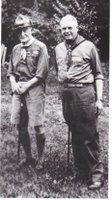
In 1926, Lord Robert Baden-Powell, the founder of Scouting, and James E. West, the first Chief Scout Executive in the United States, visited Camp Parsons. Lord Baden-Powell, along with his wife, planted a maple seedling that matured into a large tree. The present status of the tree is still hotly debated today but some believe it to be just west of the Silver Marmot Grill.
In June 1927, the Order of the Silver Marmot, precursor to the Order of the Arrow in Seattle, was formed to recognize honor campers who came to Camp Parsons. These campers were selected by leaders and scouts of the various sections in camp.
The daily camp program in the 1920’s differed each day. The only activities that stayed the same everyday were the meal schedule, bunk inspections (just before dinner) and Taps (7:45 pm). The rest of the program was posted in each site daily and varied from section to section. The Scouts had to write home three times a week. They also had Parent’s Day, where parents were able to see their sons for one day out of the two week session. The Scouts often had to be reminded to wear their swimming suits on Parent’s Day since swimming in the nude was the norm. Other program items included morning swims, calisthenics, tug-o-war (loser doused with the fire hose), rowing races, and even boxing matches. Also, an in-camp, daily newspaper, “Squirrel Barks” began publication. Scouts paid approximately $2.50 for two weeks at Camp.
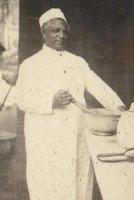
During these years the first hike from Parsons into the Olympic Mountains took place, which was an unsuccessful attempt to climb (actually to route find) The Brothers (6,866 feet). Parsons hikers made the first ascent of the Del Monte Ridge in the Olympic Mountains and named it in honor of their camp cook, Billy Del Monte (the name became official on government maps).
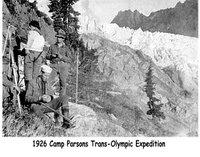
Also, Parsons Eagle Scouts hiked through the Olympic Mountains on an expedition sponsored by The Seattle Star newspaper. They reached the Queets Basin on the “back side” of Mount Olympus and emerged with exciting photos of the mountain wilderness. Mountain hikes became a regular program feature each summer through 1950. Boy Scouts from Camp Parsons made the second ascent of Mt. Anderson, the first ascent of Mt. Tom (named after a young scout who was the first in his group to summit that peak) and developed most of the trails from the Dosewallips watershed (Olympic Mountains: A climbing guide; pg 26-27; 2006).
The 1930’s
As of 1931, the only road going into Camp Parsons went around Campfire Point and entered the main camp entrance, which was located in front of the present location of Royal Basin cabin. When scouts arrived at camp, they were assigned to campsites, or sections, according to their age, abilities, and past camp performance. These sections were named after the rivers and mountains encountered along hike routes in the Olympic Mountains. The original sites were Mt. Constance, Copper City, Quilcene, Dungeness, Skokomish, Mt. Angeles, and Dosewallips. These sites were arranged in a horseshoe formation around the Silver Marmot Grill. Each campsite had a flag hanging in the then Booth Hall (SMG today) to indicate where they were to eat. Those original flags can be found in the camp museum.
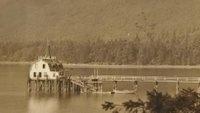
The older scouts (campers who had been to Parsons two previous summers and were at least 15) were split into three advanced sections: Explorers (pioneering and mountain hiking), Rangers (forestry and woodcraft), and Mariners (aquatics). These sections were scattered throughout the camp. The Mariners House (built in 1928) was at the sea-end of the Pier and Rangers at the current Rangers cabin (built in 1937), and the Explorers spent most of their time in the mountains.
Sometime in the early part of this decade Enna, Lewis & Clark, and Dosewallips (the director’s cabin) cabins were built just east of the Pier where all three still stand today. Enna, a name derived from the Chinook Jargon word for “beaver” was originally known as “The Drake Hotel” and apparently served as the camp office for a period of time. Lewis & Clark was named after Ted Lewis and H. Glover Clark, who were early Camp Parsons Staff members who built that cabin. Grover Clark also supervised the construction of the Blockhouse. Both men later played key roles in the development of Camp Meany. Clark served as its first director and Lewis built the Meany section cabins and “hospital,” which served as the Parsons Health Lodge for 62 years. Dosewallips was originally “The Chief’s Cabin.” In the 40’s and ‘50s, “The Chief” was Seattle Council Executive T. Byron Hunt. This was his cabin whenever he visited Parsons although it was also used for occasional Scoutmasters’ meetings. Hunt Lake at Camp Brinkley is named in his honor as is the T Bar H ranch on the Cascade Scout Reservation.
Camp Meany was established next to Camp Parsons in 1937 for Cub Scouting, a new program for younger boys. The center for this activity was around a building that is now the Dining Hall. The new camp’s namesake, Edmund S. Meany was a popular history teacher at the University of Washington around the turn of the century. He was one of the first teachers in the northwest to lecture on Forestry. Later in life he was one of the founders of the famous Mountaineers skiing and hiking club and became very active in Scouting and one of its strongest supporters. Professor Meany was also part of the delegation that selected the property which is now Camp Parsons.
In 1939, work began to reroute the camp road (now Bee Mill Road) which until then had run around the base of Campfire Point and up the west side of the (Old) Parade Ground. The “new” road actually cut through the upper parts of camp and is used today as the intercamp road.
The 1940’s
Scouts were rated during their stay at camp by their peers and staff. “S” stood for satisfactory and “H” for honor camper. This was the basis for selection to the Order of the Silver Marmot. By the 1940’s, the order had grown into a full-blown honor society with officers and an annual Christmas party.
Camp Meany was closed in 1942 and the facility was absorbed by Camp Parsons. The former Cub sections were renamed Dungeness, Skokomish and Mt. Mystery. Many staff members were drafted into World War II (Senior Staffers Claude Covington and Bud Shay lost their lives in the war).
The Olympic Mountain hikes were continued although with gas rationing, they began hiking right out of camp as in the early years.
A Rangers hike to mile-high Royal Basin found the antlers of a 12-point Olympic elk and brought them back as a permanent trophy of wilderness high adventure. These antlers hang in the Silver Marmot Grill today.
The 1950’s
Prior to 1951, participants came to camp as individual scouts, not as troops as they do today. They were formed into sections and staff members served as “Scoutmasters.” The beginning of this decade brought the troop system to camp. Organized troops from Seattle would come to camp as a single unit under their own leadership. Many of the old sections were dismantled and more campsites were formed, still utilizing the names of the mountains and rivers of the Olympic Peninsula. The Mariners section was also dismantled. In 1952 the Olympic Hikes were discontinued. It has long been believed that this was due to a death of a scout on Mt. Carrie but from what we can gather that was not true. The actual reason is unknown but this was the time when provisional camping came to an end and troop camping began and may be more due to that.
Banting Lodge was built around this time specifically to serve diabetic Scouts. It was named after Sir Frederick Grant Banting, the Canadian doctor who discovered insulin in 1921. For two weeks each summer in the 1950’s, diabetic Scouts from troops throughout the Northwest, including Canada, would come to Parsons and form a provisional troop. Under the care of nurses and dietitians, they came as close as possible to enjoying the same activities as the other Scouts. Near the end of his life, Reginald H. Parsons returned to a Council camping committee meeting to protest the installment of electricity into camp. Parsons passed away June 9, 1955 after a long illness at age 82.
The Order of the Arrow came to the Seattle area in 1954, and so as not to have competing honor societies, it was decided to end the Order of the Silver Marmot, and allow its members to transition into the OA. The name of the new OA Lodge (T’Kope Kwis Kwis) was taken from the Chinook Jargon name for the Silver Marmot.
In 1955, the Rifle Range opened at camp, directed by Marine Corps sergeants who were assigned to the camp staff. In 1958 the Parsons Staff jacket was changed from a maroon color to bright red. The following year, a national policy mandated that special camp events be Scoutcraft oriented and this led to the beginning of the Hullabaloo, instituted by Camp Director Don Hall.
The 1960’s
The Blockhouse was refurbished in 1960 and renamed Fort Duckabush. It also served as staff quarters until 1966. Prior to being the camp museum it served as a museum of natural history.
Olympic Hikes began again in 1960 under the direction of Tom Hudson and carried on into the late 60’s before it was discontinued once again only to be re-born shortly thereafter as High Adventure at Camp Sheppard. The reason for this discontinuation is uncertain as well but most like was due to logistical reasons.
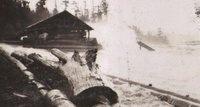
The 1962 the Columbus Day storm caused serious damage to the pier and, the boathouse at the land-end of the Pier had to be dismantled. A new 450 foot pier was constructed in 1963, lasting until 1981.

In 1964, the Thunderbird was chosen as the symbol of the Camp Parsons staff and this emblem was sewn on the red poplin scout jacket.
The camp celebrated its 50th summer with a return of old traditions such as tug-o-war through the spray of a fire hose and morning swim in the canal before breakfast.
National policy strongly encouraged tent camping during these years. The remaining campsite buildings as well as the 2nd floor “tower” on the Dining Hall were dismantled leaving only a few of the bigger cabins, the kybos, and certain program buildings.
The 1970’s
Beginning in the 1960’s, the camp went through a 3-phase renovation. In 1977 this project was completed with electricity being the “final” phase, placed in every campsite thereby replacing the need for propane tanks for hot water. Two new campsites were added to camp, Mt. Turner and Mt. Anderson. Two sets of duplexes were built to house older staff and families of senior staff members. These occupied the area where Mystery Beach Lodge is now located. These duplexes were called Hoh, Soleduck, Quinalt, and Elwha. The camp celebrated the 200th anniversary of the United States in July of 1976.
The water supply for camp had always been from a surface source, Lost Creek. It was first collected behind a dam and, passed through a screened drain which then fed into a holding tank where it underwent chlorination. In 1977, a severe drought hit the Pacific Northwest and the water supply completely evaporated. The Brinnon Fire Department had to come on a regular basis with its water tanker to fill the holding tank so that the camp could finish off the last week of summer.
In 1979, the Hood Canal floating bridge sank during a winter storm. This required scouts to either drive around through Olympia or take two ferries to reach the Olympic Peninsula. Camp went on as scheduled but attendance dropped dramatically. The bridge was finally repaired in 1982.
As 1979 drew to a close, an ambitious renovation project was undertaken. As a result of new regulations, surface water systems could no longer be used to supply camp. Two wells were dug on the north side of camp and a completely new water system was plumbed through camp. This required the development of new roads through camp and was the first major change to the camp design in 30 years. A new 32,000-gallon holding tank was built and the old tank, located next to Rangers, was abandoned but not torn down until 2001.
The 1980’s
At the beginning of the 1980 season, staff members arrived at camp to find that the staff jacket color had been changed from red to blue, and also found that the entire camp was still in disrepair after the new water system had been installed. During staff week, all effort was placed into filling the large ditches made for the water system. It was quickly realized that 2 wells would not support the camp system, so a third well was dug behind the Dining Hall and found to be an artesian salt well. A fourth well was dug and with three functioning wells, camp could finally support its population.
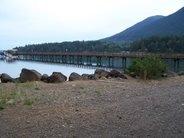
In 1980 during routine inspection, it was noted that the pilings supporting the pier were rotting to such a degree that the pier had to be condemned. A capital campaign was held to raise money to build a new pier and renovate the dining hall. In 1982, the new pier was complete and opened for the summer. At over 500 feet, it is the longest pier in any Boy Scout camp in the United States. A rock wall was put into place on the beach to prevent further erosion. In 1984, the kitchen was dismantled and a new, smaller kitchen was built on the opposite end of the current dining hall where it remains today. Also that year, the Boathouse and ramp were completed at Pier Beach.

1982 saw the return of High Adventure to camp. Participants who completed the hike were awarded the Silver Marmot award. 1984 saw the return of the Order of the Silver Marmot that incorporated many of the traditions of the previous Order (other than that represented by OA) and folded the requirements of the hike into admittance to the Order. Ranks were reinstated and based on staff position and years served on staff.
Many campsites changed during this time. Mt. Mystery was taken out of service and Scoutcraft moved into this area where it remained for almost 10 years. The Upper Lena cabins now inhabit this area. Mt. Constance was moved back from the slopes of central beach and re-situated into an area that was the former cross camp trail. The old beach trail was closed due to erosion.
In 1987, Royal Basin Cabin was built opposite of Fort Duckabush on the site where the first scouts camped in 1919. The house was donated by the local builders association and was the display house for the Home Show of 1986. The staff tents were slowly phased out and the development of year round shelters were undertaken. The group of cabins on the SMG side of camp were built in 1987 and named Lower Lena with the cabins on the Dining Hall side called Upper Lena, built in 1990. In 1989, the duplexes were dismantled and Mystery Beach Lodge was built. The Archery Range was moved from the area between Olympus and Copper City and placed into its current position. In 1988, Scoutcraft moved into the old Archery area. The High Adventure program received National Accreditation and was featured in Scouting Magazine.
As the decade came to an end, camp attendance was beginning to grow and reached a point where a lottery system was used to select troops to come to camp. It was also realized that the camp was quickly outgrowing its water supply. A fifth well and new holding tank were constructed on the northeast property. The council also made the decision to clear-cut the northern properties in 1989 in order to develop a maintenance fund that would continue to support ongoing projects at all the council camps.
The 1990’s
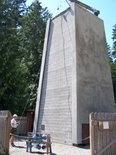
Camp Parsons celebrated its 75th summer season in 1993. A large reunion was held in downtown Seattle as well as a day of celebration at camp. Photos of this celebration can be seen in the museum at Ft. Duckabush. Mt. Deception was taken out of service and Ecology/Conservation was moved into this area before the start of the 1993 season. Banting Lodge underwent a total renovation and was refinished as a staff cabin. In 1995 the climbing tower was completed just in time for the beginning of the summer and dedicated to Francis Ledger, wife of long time camp friend and supporter, George Ledger. The Scoutcraft area moved once again in 1996 to its present location behind Quilcene. A new staff kybo was built in 1998 to replace the tired old kybo on the SMG parade field.
In 1999 the Hamma Hamma staff cabin, originally built in the 1940’s to house the Camp Director and his family, as well as the Old Health Lodge (built in 1937) were demolished. A new Health Lodge and Doctors’ quarters were completed with financial assistance from Troop 326 Scoutmaster and former Parsons Staffer, Bill Danner, along other supporters. The remnants of the old Hamma Hamma chimney still stand today.
Camp attendance continued to climb and eventually the lottery system was abandoned and few limits were placed on troops attending camp. The Dining Hall did not have the capacity to handle this volume and has led to rotating cookouts, where troops cook out at various times throughout the week. The High Adventure Program was discontinued at Camp Parsons and consolidated with other High Adventure programs at Camp Sheppard. However, the staff continued to hike the Olympics prior to camp starting as well as on the weekends during the season and after camp closed for the season.
The 2000’s
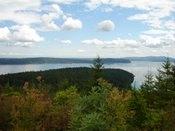
The camp’s size continued to grow, both in geography and in yearly attendance. Troops come from all parts of the United States to spend a week at one of the oldest Boy Scout camps in the U.S., now encompassing approximately 440 acres, of which only about 80 form the core camp.
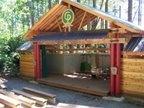
In 2002 the Fort Duckabush Museum received a new addition to house the ever increasing collection of photos and historical paraphernalia. A new rifle range and archery range were completed in 2003. After summer camp finished in 2003, the old campfire seating benches were torn down and a larger, more solid seating facility was built with the help of the alumni work party. Most recently a new kybo at Rangers was finished. Camp Parsons saw the return of High Adventure Hiking and High Adventure Canoe/Kayaking to the summer program. At the end of camp in 2005, Met Jr. was dismantled and new seating and stage facilities were built to accommodate more scouts and to bring back some of the old traditions that Met Jr. had before. 2006 and 2007 saw the return of weekly plays at Met Junior, reviving the traditional Snow White and the 7 dwarfs. The arboretum continues to develop with new signage and facilities being built. The official 5 mile hike now winds its way through all of camp’s property showing off fantastic scenery as well as the arboretum.
A celebration of the 90th summer season was held at the Museum of Flight in Seattle on June 20th and at Camp on June 21st. Many alumni came to visit including Former Governor and US Senator Daniel Evans who gave a very brief yet moving recollection of his time at camp and how it shaped his life. The camp was also visited by Reginald Parsons’s grandchildren who donated to the museum Reginald’s original Silver Beaver presented to him by the Seattle Council in 1936.
In 2010, the Silver Marmot Grill (Booth Hall) was renovated to appear very much as it did in 1919. It serves as the Scoutmaster Lounge, meeting room, Program and Management offices. The new Trading Post was completed in 2012 and saw its first operation that summer. The former Program Office was razed as it was no longer able to be maintained.
Today, Camp continues to look forward the return of scouts for the summer season and to the ongoing program it provides for those scouts.
